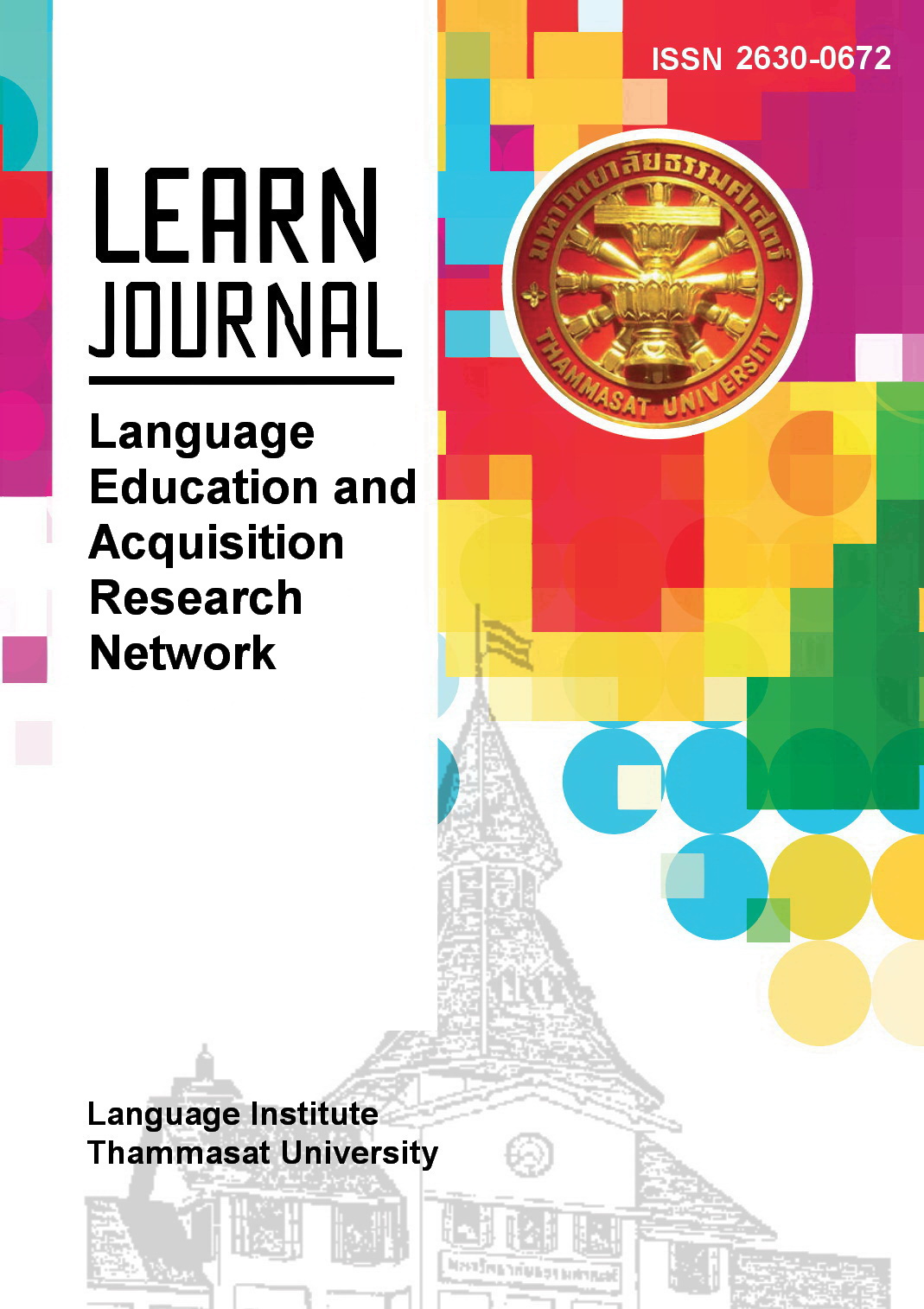Exploring Persuasive English Language in MasterClass’s Video Advertisements
Main Article Content
Abstract
This study examines the persuasive English language in MasterClass’s video advertisements. An analysis framework was formed using twenty-four techniques to identify persuasive language, and the purposes of using different techniques in one hundred and forty-one MasterClass’s video scripts. The analysis included identifying the primary argument of the scripts, evaluating language formality and style, indicating persuasive techniques and their examples, and comparing the frequency of each technique from most to least used. The findings showed that the majority of the introduction and body of the scripts were devoted to the contents: critical concepts in the lessons, class contents and activities, backgrounds and experiences of the instructors, methods and processes for developing skills, and professional tips and techniques. The script’s conclusion frequently reflected the instructors’ attitudes and perspectives. These contents were persuaded using various techniques with different purposes. The top ten persuasive techniques employed in the advertisements were repetition, colloquial language, inclusive language, rhetorical questions, connotations, jargon, anecdotes, hyperboles, similes, and generalizations. The results can be applied as resources for language educators to design persuasive language lessons. Besides, for those interested in creating more effective video advertisements, the findings can help prepare advertising scripts for educational purposes or commercials.
Article Details
References
Anigbogu, N. C., & Okere, M. C. (2021). Persuasive language in advertising: Linguistic analysis of Stanbic IBTC and access banks’ online advertisements. Journal of humanities and social science (IOSR-JHSS), 26(6), 41–46. https://doi.org/10.9790/0837-2606034146
Armstrong, J., Lukeman, G., & Patnaik, S. (2010). Persuasive advertising: Evidence-based principles. http://ci.nii.ac.jp/ncid/BB03612423
Auliya, S., & Hastuti, S. (2022). An analysis of persuasive techniques used in Maybelline New York’s Instagram captions. Jurnal Bahasa Inggris Terapan, 8(1), 18–28. https://doi.org/10.35313/jbit.v8i1.3884
Basaraba, N. (2016). Creating persuasive book trailers as a new media marketing tool. Logos, 27(3), 34–51. https://doi.org/10.1163/1878-4712-11112110
Beardwood, R. (2018). English year 11 (2nd ed.). Insight Publications.
Breuer, I., & Napthine, M. (2008). Persuasive language in media texts. Insight Publications.
Cambridge University Press. (2022). Bloom. In Cambridge Dictionary. https://dictionary.cambridge.org/dictionary/english/bloom
Chapin, M. (2020, September 9). What are the common types of digital video ads?. Market Mentors. https://marketmentors.com/advertising/digital-advertising/common-types-of-digital-video-ads/
Chocano, C. (2020, September 15). What is MasterClass actually selling? The Atlantic. https://www.theatlantic.com/magazine/archive/2020/09/what-is-masterclass-actually-selling/614200/
DeGuzman, K. (2022, January 2). What is repetition - definition and examples for writers. Studio Binder. https://www.studiobinder.com/blog/what-is-repetition- definition/
Farlex. (2022). Bust one’s ass. In The free dictionary by Farlex. https://idioms.thefreedictionary.com/bust+one%27s+ass
Gao, G. (2020, June 26). How to download YouTube subtitles as text (video transcripts/captions into google doc). [Video]. YouTube. https://www.youtube.com/watch?v=xQUumeGW8Q4
Gómez, M. L. (2012). Informing or persuading travelers: the language of airlines advertisements. AULA: Revista de Pedagogía, 18, 81-94. https://www.semanticscholar.org/paper/Informing-or-persuading-travellers%3A-the-language-of-Gómez/bdc83b86a9ea748552d6cca0dcdcdbf89acea363
Heckmann, C. (2020, December 20). What is connotation? definition & examples in literature & film. Studio Binder. https://www.studiobinder.com/blog/what-is-connotation-definition-examples/
Kartika, Y., Rohmah, A., & Andriani, D. (2020). An analysis of jargon used on facebook found in account “Mark Zuckerberg.” Channing, 5(2), 63–70. https://doi.org/10.30599/channing.v5i2.832
Kelliher, E. (2018, November 5). In vod we trust. Adworld. https://www.adworld.ie/2018/11/05/in-vod-we-trust/
Knolle, S. (2022, February 8). Gumby is back: Classic claymation character sets up shop at Fox. TheWrap. https://www.thewrap.com/gumby-coming-to-fox/
Labrador, B., Ramón, N., Alaiz-Moretón, H., & Sanjurjo-González, H. (2014). Rhetorical structure and persuasive language in the subgenre of online advertisements. English for Specific Purposes, 34, 38–47. https://doi.org/10.1016/j.esp.2013.10.002
Lamb, B. (2019). Persuasive language. Creative Content Australia. http://nothingbeatstherealthing.org.au/wp-content/uploads/2020/07/PersuasiveLanguage_2019.pdf
Losi, R. V., Bernardo, T. J., Sibuea, T. F. B., & Ananda, R. (2022). The persuasive techniques of Starbucks and Burger King advertisements on Instagram posts. International Journal of English and Applied Linguistics (IJEAL), 2(2), 313–324. https://doi.org/10.47709/ijeal.v2i2.1676
Macquarie Dictionary. (2022). Gumby. In Macquarie Dictionary Online. Retrieved February 8, 2022, from https://www.macquariedictionary.com.au/resources/aus/ word/map/search/word/gumby/Hunter Valley and North Coast/
Matthews, K. (2019, December 30). “The complete guide to online video advertising”. Outbrain. https://www.outbrain.com/blog/online-video-advertising- guide/
Momayezalashjar, E., & Shuraki, F. (2022). Analysis of linguistic features and persuasive techniques used in advertisements of learning a language on social media in Iran. Journal of Studies in Learning and Teaching English, 11(2), 125–163.
Nevins, J. (2020, May 25). It’s the year 2120. MasterClass is the only school left. The New York Times. https://www.nytimes.com/2020/05/25/style/masterclass-secrets.html
Nothing Beat the Real Thing. (n.d.). Persuasive language.
https://nothingbeatstherealthing.org.au/education-resources/persuasive-language/
Oyeleye, A. L., & Adeyinka, I. A. (2014). Rhetoric and lexicalization as aspects of persuasive strategy in the language of insurance advertising in the Nigerian print media. International Journal of Applied Linguistics & English Literature. 3(5), 276-286. http://doi.org/10.7575/aiac.ijalel.v.3n.5p.276
Romanova, I. D., & Smirnova, I. V. (2019). Persuasive techniques in advertising. Training, Language and Culture, 3(2), 55-70. http://doi.org/10.29366/2019tlc.3.2.4
Rudito, Y. Y., & Anita. (2020). Persuasive strategies used in Burger King’s Instagram posts caption. Journal of Language & Literature, 8(1), 96–104. https://doi.org/10.35760/jll.2020.v8i1.2141
Shrum, L. J., Lowrey, T. M., & Pogacar, R. (2018). The effects of linguistic devices on consumer information processing and persuasion: A language complexity × processing mode framework. Journal of Consumer Psychology, 28(4), 689-711.
Zimmer, J. (2020). Rhetorical devices: Hypophora. Manner of Speaking. https://mannerofspeaking.org/2012/01/25/rhetorical-devices-hypophora/


